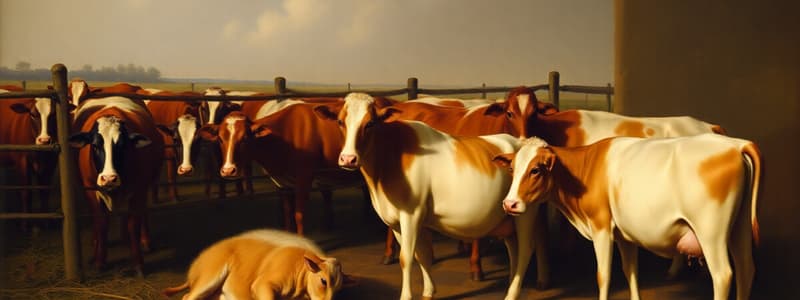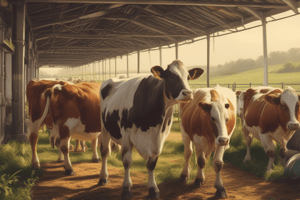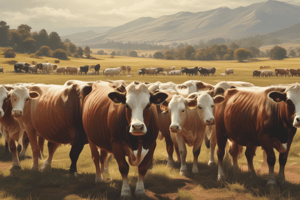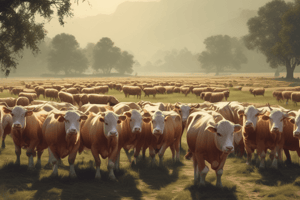Podcast
Questions and Answers
Welches dieser Elemente trägt zur Verbesserung des Tierwohls bei?
Welches dieser Elemente trägt zur Verbesserung des Tierwohls bei?
- Bessere Unterbringung und Handhabung (correct)
- Erhöhung der Dichten in Ställen
- Reduzierte Futtervielfalt
- Eingeschränkter Zugang zu Wasser
Was ist ein Vorteil von Weidewechsel?
Was ist ein Vorteil von Weidewechsel?
- Erhöhte Tierdichte
- Erhalt der Gesundheit der Weide (correct)
- Reduzierung der Tierzahl
- Verminderung der benötigten Futtermenge
Welches Problem kann durch Preisfluktuationen bei Futter auftreten?
Welches Problem kann durch Preisfluktuationen bei Futter auftreten?
- Erhöhte Nahrungsmittelproduktion
- Erhöhte Umweltbelastungen
- Verminderte Rentabilität von Betrieben (correct)
- Verbesserte Tiergesundheit
Welche Strategie ist wichtig für das Management der Weidebedingungen?
Welche Strategie ist wichtig für das Management der Weidebedingungen?
Welche Herausforderung steht der Tierhaltung in Bezug auf Krankheiten gegenüber?
Welche Herausforderung steht der Tierhaltung in Bezug auf Krankheiten gegenüber?
Was ist ein Hauptzweck der Tierhaltung?
Was ist ein Hauptzweck der Tierhaltung?
Was wird in der Milchwirtschaft primär produziert?
Was wird in der Milchwirtschaft primär produziert?
Welche Aussage beschreibt ein wichtiges Element des Tierwohls?
Welche Aussage beschreibt ein wichtiges Element des Tierwohls?
Welcher Faktor kann NICHT als umweltbedingter Einfluss auf Tierhaltungspraktiken betrachtet werden?
Welcher Faktor kann NICHT als umweltbedingter Einfluss auf Tierhaltungspraktiken betrachtet werden?
Was versteht man unter Präzisions-Tierhaltung?
Was versteht man unter Präzisions-Tierhaltung?
Was beschreibt die Schweinehaltung hauptsächlich?
Was beschreibt die Schweinehaltung hauptsächlich?
Was ist ein häufiger wirtschaftlicher Einfluss auf die Tierhaltung?
Was ist ein häufiger wirtschaftlicher Einfluss auf die Tierhaltung?
Welche der folgenden Aussagen über die Haltungsbedingungen ist wahr?
Welche der folgenden Aussagen über die Haltungsbedingungen ist wahr?
Flashcards
Nachhaltige Tierproduktion
Nachhaltige Tierproduktion
Tierhaltung, die die Umweltbelastung durch nachhaltige Futtermittel und Abfallminimierung reduziert.
Verbessertes Tierwohl
Verbessertes Tierwohl
Verbesserte Haltungsbedingungen für Tiere durch bessere Unterbringung, Anreicherung und Umgang.
Rotationsweide
Rotationsweide
Regelmäßige Bewegung von Tieren auf verschiedene Weiden, um die Gesundheit der Weiden zu erhalten und Überweidung zu verhindern.
Futtermittelkosten
Futtermittelkosten
Signup and view all the flashcards
Umweltbelastung durch Tierhaltung
Umweltbelastung durch Tierhaltung
Signup and view all the flashcards
Tierhaltung
Tierhaltung
Signup and view all the flashcards
Viehzucht
Viehzucht
Signup and view all the flashcards
Milchwirtschaft
Milchwirtschaft
Signup and view all the flashcards
Geflügelzucht
Geflügelzucht
Signup and view all the flashcards
Schweinezucht
Schweinezucht
Signup and view all the flashcards
Schafzucht
Schafzucht
Signup and view all the flashcards
Aquakultur
Aquakultur
Signup and view all the flashcards
Tierschutz
Tierschutz
Signup and view all the flashcards
Study Notes
Introduction to Tierhaltung
- Tierhaltung, meaning animal husbandry, encompasses the practice of raising and caring for animals for various purposes, including food production, companionship, research, and entertainment.
- Different types of animal husbandry exist depending on the species and intended use. This includes methods for housing, feeding, and managing animals.
Types of Animal Husbandry
- Livestock farming: Focuses on raising animals like cattle, pigs, sheep, and poultry primarily for meat, milk, or eggs.
- Dairy farming: Specializes in the production of milk from cows or other mammals.
- Poultry farming: Involves raising chickens, turkeys, and other poultry for meat and eggs.
- Pig farming: Concentrates on raising pigs for meat production.
- Sheep farming: Focuses on raising sheep for wool, meat, and sometimes milk.
- Aquaculture: The farming of aquatic organisms like fish, shellfish, and seaweed for food.
Ethical Considerations in Tierhaltung
- Animal welfare: A crucial aspect of responsible animal husbandry. It involves ensuring the physical and mental well-being of animals.
- Housing conditions: Adequate space, ventilation, and shelter are critical to preventing stress and disease.
- Nutrition: Providing balanced and appropriate diets to support the animal's growth and health.
- Health management: Regular health checks, disease prevention, and appropriate treatment are essential for animal welfare.
- Minimizing stress: Reducing factors that cause stress, such as overcrowding and handling procedures.
Factors Affecting Tierhaltung Practices
- Environmental factors: Climate, terrain, and availability of resources greatly impact choices regarding animal housing and feed production.
- Economic factors: Profitability often plays a significant role in choosing breeds, feeding strategies, and overall management decisions.
- Technological advancements: New technologies are constantly improving practices, such as feeding systems, housing design, and disease control.
- Legislative regulations: Governments often impose regulations to ensure animal welfare and food safety, setting standards for housing, feeding, and handling animals.
Future Trends in Tierhaltung
- Precision livestock farming: Using technology like sensors and data analytics to collect and analyze information on animal health and production, leading to more efficient and sustainable methods.
- Sustainable animal production: Shifting towards practices that reduce the environmental impact of animal farming, like using sustainable feed sources and minimizing waste.
- Improved animal welfare: Emphasis on enhancing animal welfare standards through better housing, enrichment, and handling practices.
- Consumer demand: Increasing consumer awareness regarding animal welfare and sustainable food production is influencing farming techniques.
Specific Animal Husbandry Practices
- Rotation grazing: Regular movement of livestock to different pastures to maintain pasture health and prevent overgrazing.
- Pasture management: Maintaining optimal pasture conditions—fertility, weed control, and water access—is crucial.
- Feeding strategies: Tailoring diets to meet specific animal needs at various stages of their lifecycle.
- Breeding programs: Selective breeding plays a role in improving traits desired, like growth rate, milk production, or disease resistance.
Challenges & Problems in Tierhaltung
- Disease outbreaks: Animals can be susceptible to various diseases, requiring proactive health management and biosecurity protocols.
- Feed costs: The price fluctuations of feed can heavily influence the profitability of farms.
- Environmental impact: Animal agriculture can contribute to greenhouse gas emissions, water pollution, and land degradation.
- Maintaining animal health: Preventing and treating diseases, monitoring animal health, and ensuring hygiene are complex and ongoing tasks.
Conclusion
- Tierhaltung is essential for providing food and other products.
- Ethical considerations are crucial to ensure animal welfare.
- Sustainable and technologically advanced methods are important trends.
- Addressing challenges like disease outbreaks and environmental impacts is vital for the future of responsible animal husbandry.
Studying That Suits You
Use AI to generate personalized quizzes and flashcards to suit your learning preferences.




